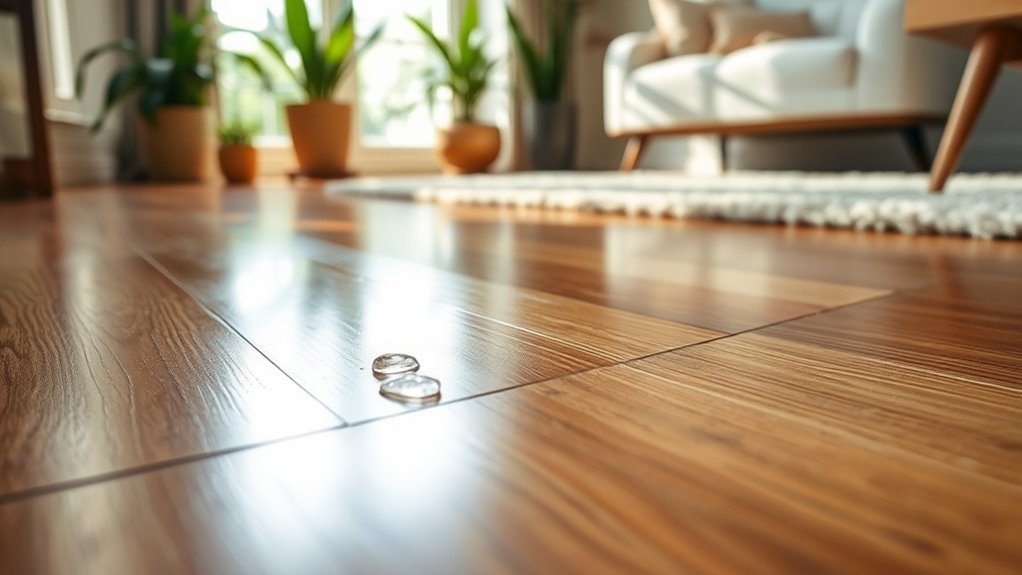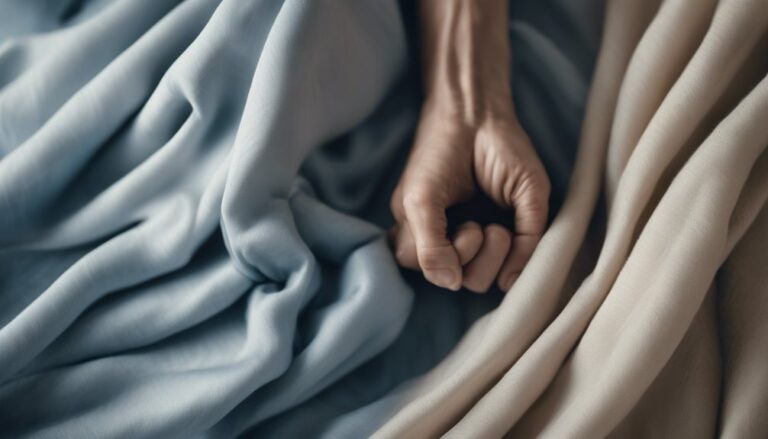If you seal laminate flooring, you risk trapping moisture beneath its wear layer, causing swelling, warping, or even fungal growth. Sealants can chemically react with the laminate’s protective surface, leading to peeling, bubbling, or discoloration. Using non-recommended sealants may void warranties and reduce floor integrity. Instead, protect your floor with manufacturer-approved coatings and other preventive measures. To fully understand when and how sealing might be appropriate, consider the composition and specific vulnerabilities of laminate flooring.
Understanding the Composition of Laminate Flooring
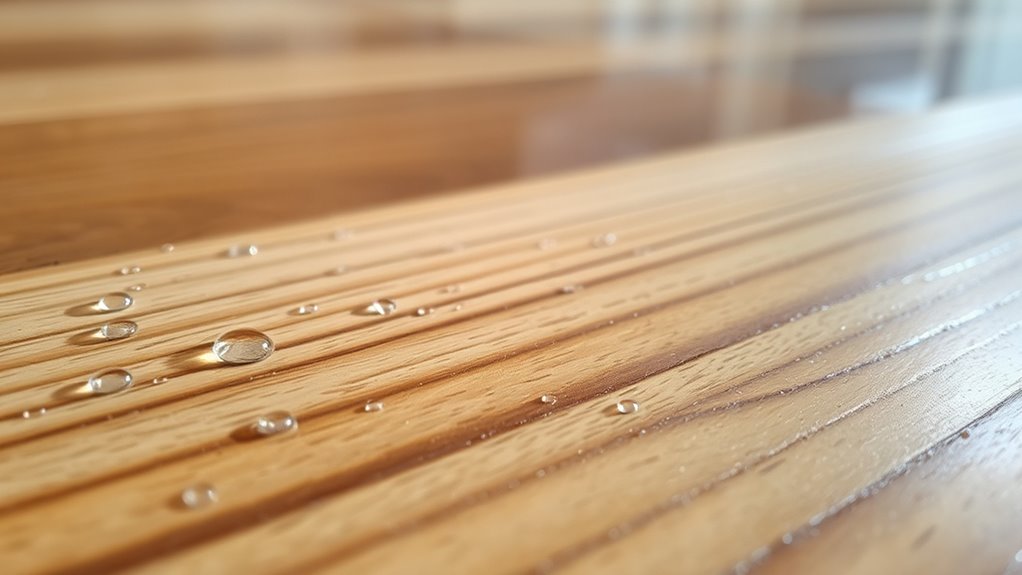
Although laminate flooring is often mistaken for solid wood, it’s actually a multi-layered synthetic product designed to mimic natural materials. You’ll find that laminate layers consist primarily of a wear layer, a decorative layer, a core layer, and a backing layer. The top wear layer provides durability and resistance to scratches, while the decorative layer replicates the appearance of wood or stone. The core layer, typically made from high-density fiberboard or HDF, offers structural stability and moisture resistance. Finally, the backing layer protects against moisture from below and adds balance to the flooring. These laminate layers combine advanced flooring materials engineered to deliver strength and aesthetic appeal, granting you the freedom to enjoy a wood-like floor without the constraints of natural wood’s vulnerabilities.
Common Sealants Used on Floors
Knowing the layers that make up laminate flooring helps you understand why applying sealants requires careful consideration. Common sealants for floors include polyurethane, acrylic, and wax-based finishes, each designed to enhance durability and resistance. Polyurethane sealants provide a hard, protective layer, often favored for hardwood but can alter laminate’s surface texture. Acrylic sealants offer a thinner, water-based finish that dries quickly without heavy buildup, maintaining the floor’s original look. Wax-based finishes, though less common today, add a slight sheen but can attract dirt and complicate maintenance. When selecting floor finishes, it’s essential to match the sealant’s chemical properties with laminate’s composite structure to avoid damage. Understanding these common sealants helps you make informed decisions that preserve your floor’s integrity and your freedom to maintain it as you see fit.
Potential Risks of Sealing Laminate Flooring
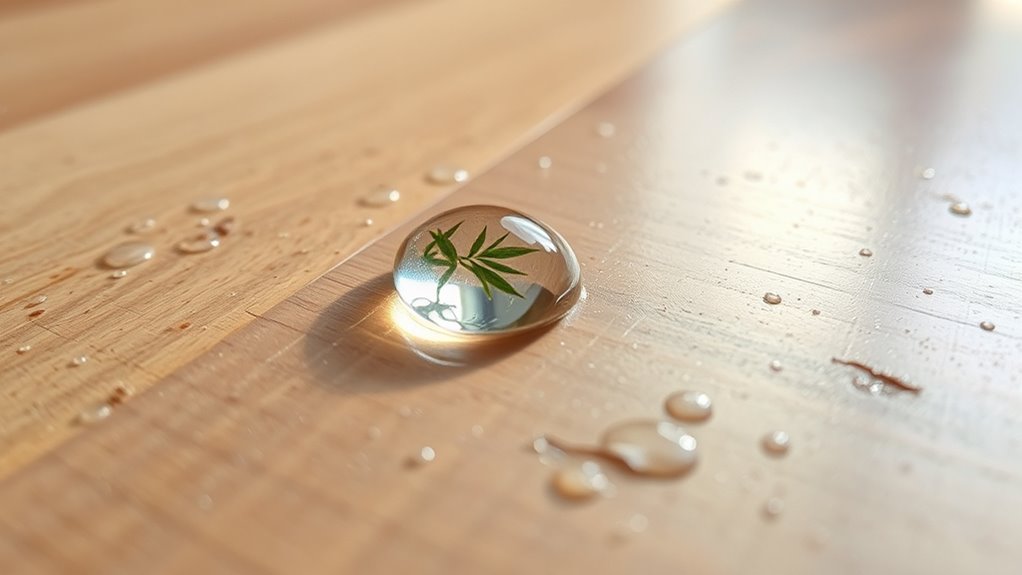
If you seal laminate flooring improperly, you risk trapping moisture beneath the surface, which can cause swelling or warping. Additionally, applying sealants not recommended by the manufacturer may void your flooring warranty. It’s essential to understand these risks before proceeding with any sealing process.
Moisture Damage Risks
When you seal laminate flooring improperly, it can trap moisture beneath the surface, leading to swelling, warping, and delamination. Laminate floors rely on a balance of moisture absorption and vapor exchange to maintain structural integrity. By sealing the surface incorrectly, you disrupt this balance, creating pockets where water damage can develop unnoticed. Trapped moisture increases the risk of fungal growth and compromises the floor’s dimensional stability. Since laminate flooring is not waterproof, excess moisture absorption through sealed edges or cracks intensifies deterioration. To avoid these moisture damage risks, guarantee proper installation and ventilation instead of relying on sealing. Understanding these technical implications helps you preserve your flooring’s lifespan without restricting necessary moisture movement.
Warranty Void Issues
Several laminate flooring manufacturers explicitly state that applying sealants or coatings to the surface can void your warranty. Ignoring manufacturer guidelines means you risk losing coverage for defects or damages that would otherwise be protected. Understanding these warranty implications is essential before sealing your floor.
Key warranty implications include:
- Loss of protection against surface wear or delamination
- Voided coverage for moisture-related damages
- Denial of claims related to structural integrity issues
- Cancellation of any extended warranty agreements
How Sealants Interact With Laminate’S Wear Layer
Although laminate flooring is designed with a durable wear layer to resist scratches and moisture, applying sealants can alter its protective properties. The wear layer interaction with sealants isn’t always beneficial; sealants may create a barrier that traps moisture beneath or interfere with the laminate’s engineered surface. This can compromise sealant effectiveness, leading to peeling, bubbling, or discoloration. Additionally, some sealants may react chemically with the wear layer, degrading its integrity over time. When you apply a sealant, you risk disrupting the balance between protection and breathability the wear layer provides. Understanding this interaction is vital before sealing your floor, as improper application can reduce the laminate’s lifespan and performance rather than enhance it.
Alternative Methods to Protect Laminate Floors
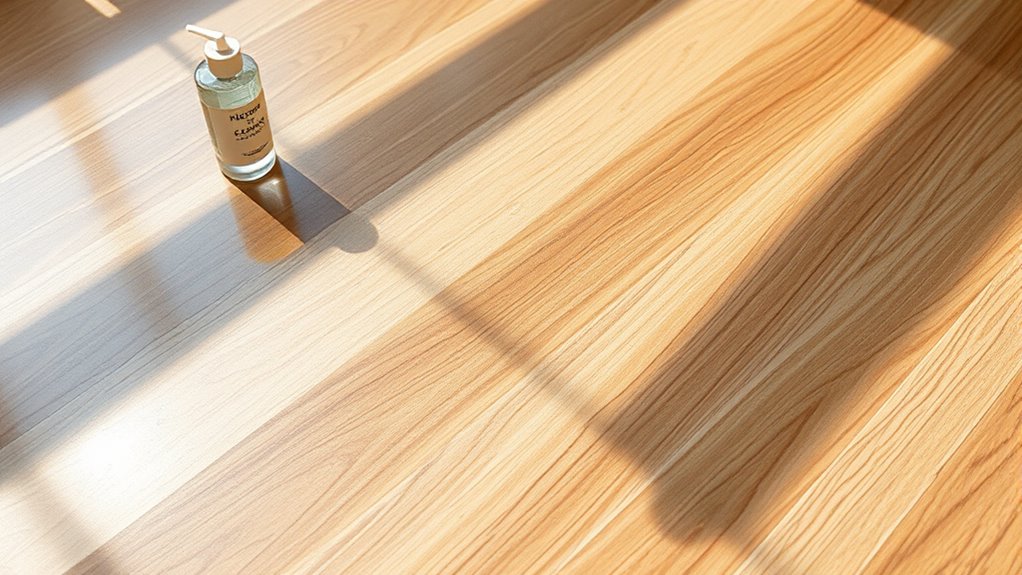
You can enhance your laminate floor’s durability by applying protective floor coatings designed specifically for this material. Additionally, using furniture pads under legs and placing rugs in high-traffic areas helps minimize scratches and wear. These methods offer effective alternatives to sealing without compromising the floor’s integrity.
Protective Floor Coatings
When aiming to extend the lifespan of laminate flooring beyond its factory finish, applying protective floor coatings offers a viable alternative. These coatings enhance floor maintenance by forming a durable barrier against scratches, moisture, and wear. You’ll find specialized polyurethane or acrylic-based coatings designed specifically for laminate surfaces, ensuring compatibility and preserving appearance. Consider these protective measures:
- Water-based polyurethane for clear, non-yellowing protection
- Acrylic coatings that dry quickly and resist abrasion
- Epoxy coatings offering superior chemical and impact resistance
- UV-cured coatings providing fast curing and enhanced durability
Applying these coatings requires careful surface preparation and following manufacturer guidelines to avoid damage. This approach grants you freedom from frequent repairs while maintaining the floor’s aesthetic integrity through precise, effective protection.
Furniture Pads and Rugs
A practical way to protect laminate floors from scratches and wear involves using furniture pads and rugs. Furniture protection starts with applying felt or rubber pads under chair legs, tables, and other movable items to prevent abrasion during shifts or movement. These pads reduce direct contact, minimizing surface damage without compromising floor integrity. Additionally, strategic rug placement offers a dual function: it cushions high-traffic zones and guards against dirt and moisture infiltration, key factors in laminate floor degradation. When positioning rugs, make certain they have non-slip backings to avoid accidents and don’t trap moisture beneath, which could cause swelling. By integrating furniture pads and mindful rug placement, you maintain your laminate flooring’s durability and aesthetic freedom, avoiding the risks associated with sealing while still providing reliable protection.
When Sealing Laminate Flooring Might Be Appropriate
Although laminate flooring isn’t designed to be sealed, there are specific circumstances where applying a sealant might be beneficial, such as in areas prone to moisture exposure or heavy foot traffic. Sealing benefits include enhanced resistance to spills and scratches, extending your floor’s lifespan when combined with proper maintenance tips. You might consider sealing if you:
- Install laminate in basements or bathrooms with higher humidity
- Have pets that frequently scratch or soil the floor
- Experience heavy foot traffic that accelerates wear
- Want additional protection during seasonal weather changes
Keep in mind that sealing isn’t a universal fix and should be done with compatible products to avoid trapping moisture. If you value freedom in floor care, weigh these factors before sealing your laminate flooring.

